Hunting for asteroids Teach article
Keen to save the world? Andy Newsam and Chris Leigh from the UK’s National Schools’ Observatory introduce an activity where you can potentially do just that: by detecting real asteroids – which may be heading for Earth.
Introduction
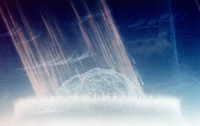
JPL-Caltech
Asteroids or minor planets are dusty, rocky, metallic objects orbiting the Sun, too small to be considered planets. Tens of thousands of asteroids have been discovered so far, and more than 12 000 officially named.
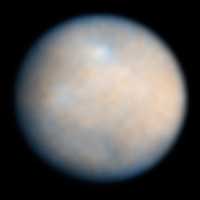
Hubble Space Telescope
Image courtesy of NASA, ESA
and J Parker (Southwest
Research Institute); image
source: Wikimedia Commons
The largest, Ceres, is 1000 km in diameter, whereas the smallest are only the size of pebbles. Only 15 asteroids have been detected with diameters above 240 km, and if you stuck all known asteroids together, you would still have an object smaller than the Moon (diameter 3500 km).
Most asteroids are found in the Asteroid Belt, between the orbits of Mars and Jupiter, but others have orbits which take them very close to Earth: these are known as near-Earth objects (NEOs). If on a collision course with Earth, they are called meteoroids. When a meteoroid strikes the atmosphere at high velocity, friction causes it to incinerate in a streak of light known as a meteor. If the meteoroid does not burn up completely, what is left strikes Earth’s surface and is called a meteorite.
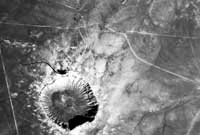
Crater in Arizona, USA, is
1.186 km in diameter and
180 m deep. It is surrounded
by a rim of smashed and
jumbled boulders, some as
big as houses; the shadow-
casting structure on the
north side of the crater is
the visitors’ centre (23
January 2004)
Image courtesy of ESA
Although many small asteroids hit Earth every day, they are too small to cause any damage. However, there have been larger ones in the past: the 1.186 km wide Barringer Crater in Arizona, USA, was created about 50 000 years ago by a meteor thought to have been just 40 m wide. Such events occur about every 1000 years, but most craters are not visible due to weathering or vegetation, or because they are under the sea.
Although it is very unlikely that a large NEO will hit Earth in our lifetime, astronomers are trying very hard to find and track as many NEOs as possiblew1. If they can find big Earth-threatening NEOs early enough, it may be possible to ‘push’ them out of the way and stop them crashing into Earth.
How do we find them? Although the positions of stars remain fixed from night to night, the Moon, planets and asteroids wander slowly between them. Unlike most planets, asteroids are too dim to be seen with the naked eye. To observe them we need binoculars or a telescope.
In the following activity devised by the UK’s National Schools’ Observatoryw2 (NSO; see box, students aged 7-19 can hunt for asteroids using images generated by the world’s largest fully robotic telescope, the Liverpool Telescope on La Palma, on the Canary Islands, Spain (8 m high, weighing 25 tonnes, with mirrors 2 m in diameter). Using the same techniques used by professional astronomers, students quickly learn how to detect real asteroids in real observations. Younger students may need an introduction from their teachers, for whom there are supporting materials onlinew3. Older students can go on to calculate the speed of the detected asteroids (see the advanced task below) and report back their data. The workshop combines information technology, physics and maths into a fun hour of discovery.
The National Schools’ Observatory
The National Schools’ Observatory (NSO) is a major educational website, established by Liverpool John Moores University, UK. It allows schools to make their own observations alongside professional astronomers with the world’s largest fully robotic telescope – the Liverpool Telescope, which has 5% of its observing time allocated to schools in the UK and Ireland. Once the observing request has been completed, students are able to download the telescope data and use special image-processing software to analyse the resulting images. The website also provides educational resources on astronomy.
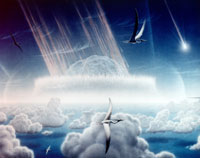
asteroid slamming into
tropical, shallow seas off the
Mexican coast, forming what
is known as the Chicxulub
crater. This asteroid impact
may have caused the
extinction of the dinosaurs.
Fortunately, asteroids large
enough (1 km or more in
diameter) to cause such
serious damage are thought
to strike only every few
million years
Image courtesy of NASA /
JPL-Caltech
Asteroid Watch
Preparation
All materials required are freely available onlinew3 without registration. Each student (or pair of students) will need a computer running Microsoft Windows®. An Internet connection is not required for the activity if the files are downloaded in advance.
- Download and install the dedicated LTImage software. This image-processing tool was developed by the NSO and adapted for simplified use in schools. LTImage can work with all image data that are in the FITS image format, i.e. with images from most professional telescopes around the world. A screencast movie guide on using the software is available online.
- Download the teacher notes, the introductory PowerPoint® presentation, and a set of student notes (available for ages 7-11 and 11-16; older students will probably not need notes).
- Introduce the activity using the PowerPoint presentation.
- Hand out a copy of the student notes to each student.
For details on how to use LTImage at the individual steps, see the teacher notes.
Making the observations
To detect the movement of asteroids, we need images of the night sky that were taken some time apart, so that they will have changed position between images. To make sure any motion we see is genuine, we will use four separate images, each taken about 30 minutes apart.
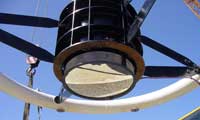
secondary mirror
Image courtesy of J Marchant
You will find the images in the ‘Data files’ section of the Hunting for Asteroids activityw3.
The ah_demo-1.fits to ah_demo-4.fits files are simulated data for you to practice on, while the ahunt-10-1-1.fits to ahunt-10-1-4.fits data are real observations of an NEO called 2001 GQ2, which were taken just before midnight on 5 April 2009.
- Save all eight images to your computer. For your first attempt, use the demonstration image set (ah-demo-1, ah-demo-2 etc.) as the images contain simulated asteroids for you to spot.
Detecting asteroids
- Start LTImage and load the first image.
You might be disappointed, since the image is probably very dark. Do not worry, this is normal and can be corrected: the camera on the Liverpool telescope was designed to count the number of photons it receives, rather than to take pretty pictures. Some of the details in the image may be so dark compared to the surrounding bright stars that we cannot initially see them. To reveal more detail from dimmer objects, we need to adjust the scaling using the two sliders in LTImage.
- Load and scale the other three images.
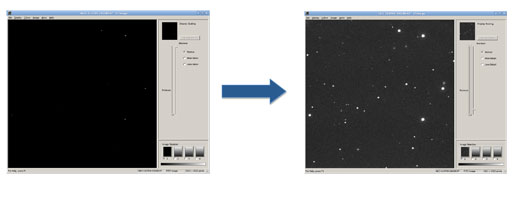
An image before and after scaling
Images courtesy of the National Schools’ Observatory - To look for asteroids, we use a technique known as blinking. To blink the images, simply look at the main viewing screen in LTImage and switch between each of the four images in quick succession. For example, look at image 1 for about half a second, then at images 2, 3 and finally 4, before returning to image 1 and repeating the process.
The stars do not move, but an asteroid will. That is all there is to it – get several images, blink them, and if something moves (in a straight line), it is an asteroid.
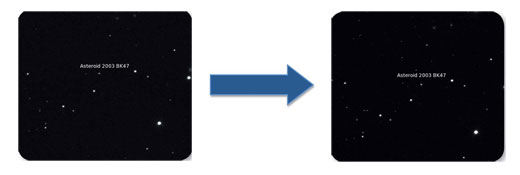
Images courtesy of the National Schools’ Observatory
In the demonstration image set, you should be able to pick out two asteroids (one is harder to spot than the other). Keep blinking the images until you are sure. You may want to try varying the time you look at each image. Note that the stars can appear to wobble due to wind and pointing variations, but asteroid movement is more obvious.
- When you are happy that you can find at least one of the moving objects in the demonstration image set, try the four images from the real image set to see if you can discover the asteroid.
Measuring the position of an NEO
- Once you have found an NEO by blinking the images, the next step is to measure its position. To find the pixel coordinate of it in each image, use the Image Examine tool in LTImage. See the ‘Measuring the position of near-Earth objects (NEOs)’ section on the Asteroid Watch activity websitew3 for detailed instructions.
- To find the X and Y coordinates, move the mouse pointer until it is right under the cross hairs on the Examine window.
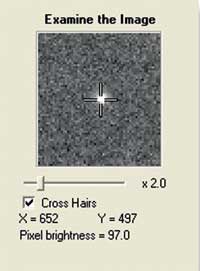
Image courtesy of the National
Schools’ Observatory - Repeat this for each NEO and image – remember to write down all your results.
The real thing
Now that you have understood how it works, you are ready to download some more recent observations of real NEOs that astronomers need to know more about. The images are of positions where recently discovered NEOs are likely to be, and the observations are needed to refine our understanding of the NEO’s orbits. Because this is real research data, we do not know for certain where or even whether there will be an NEO in the image, but there should be. There is also a small chance of another, unknown asteroid in the same field of view, of course.
- Go to ‘Download some recent observations to analyse’ on the Asteroid Watch activity websitew3, and download a set of four images. Remember to make a note of the group ID code – you will need it when reporting your results.
- Scale and blink the images, and measure the positions of any NEO you detect. There will be at least one in most observations. In about 1 in 10 cases, there will be no NEO, and in about 1 in 100, there will be two.
Submitting your results
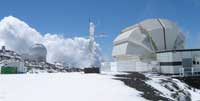
Image courtesy of J Marchant
To submit your results (the X and Y coordinates of newly identified NEOs), go to ‘Report your results’ on the Asteroid Watch activity website. Useful (non-spam) results will be passed on to the International Astronomical Union’s Minor Planet Centerw4 to improve orbital estimates.
Advanced task: calculating the speed of an asteroid
If you have time and feel confident about using a little maths with the students, you can use the demonstration image set and some of the LTImage tools to work out how far the asteroid has travelled and how fast it is going. For instructions, download the ‘More able tasks’ worksheet on the ‘Hunting for Asteroids’ activity websitew3.
Web References
- w1 – To learn how the European Space Agency is monitoring near-Earth objects, see: www.esa.int/esaMI/NEO
- w2 – To find out more about the National Schools’ Observatory, see: www.schoolsobservatory.org.uk
- w3 – The full Asteroid Watch workshop is described here: www.schoolsobservatory.org.uk/asteroids
- For the introduction to the Hunting for Asteroids activity and to download the relevant materials, see: www.schoolsobservatory.org.uk/activ/asteroids
- For information about the LTIimage software and to download it, see: www.schoolsobservatory.org.uk/astro/tels/ltimage
- w4 – Useful asteroid data is passed on to the Minor Planet Center. See: http://minorplanetcenter.net
Resources
- In the film Deep Impact, astronomers try to destroy a comet before it crashes into Earth. For a toolkit for using the film Deep Impact in the classroom, see:
- Oberhummer H, Behacker M (2006) Deep Impact. Science in School 1: 78-80. www.scienceinschool.org/2006/issue1/deepimpact
- In the ‘Galaxy zoo’ project, you help astronomers classify galaxies in images taken by the Hubble Space Telescope, while in ‘Moon zoo’, you help classify structures on the surface of the Moon. See: www.galaxyzoo.org and www.moonzoo.org
Review
After a short introduction to asteroids and the Liverpool Telescope, the article presents an activity on searching for asteroids in digital images. This can be used to link classical (distance, speed, gravity) to modern physics (astrophysics) and to earth science (the Solar System, landscapes on Earth hit by asteroids). Practical work in small groups benefits both the students and the teacher, and producing real scientific results that can be used by the scientific community is guaranteed to motivate the class.
The article stimulates comprehension questions such as:
- What are asteroids and where do they come from?
- Have asteroids hit Earth? What effects can we see on Earth?
- What are the properties of asteroids in the Solar System?
- What is the Liverpool Telescope and how does it work?
- How can you calculate the speed of and distance travelled by moving objects, such as asteroids?
Gerd Vogt, Higher Secondary School for Environment and Economics, Yspertal, Austria





